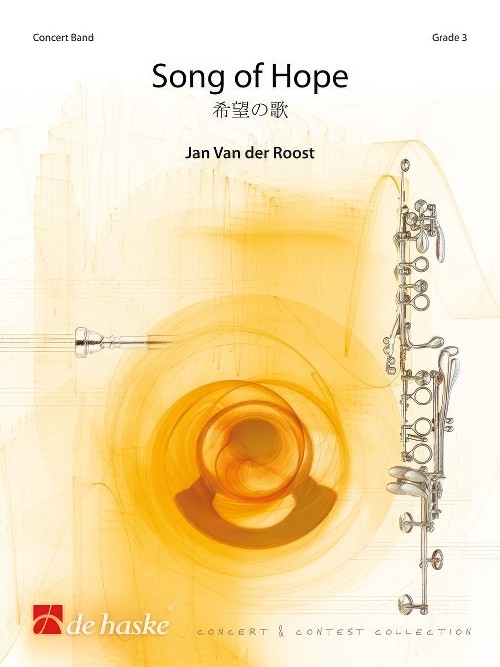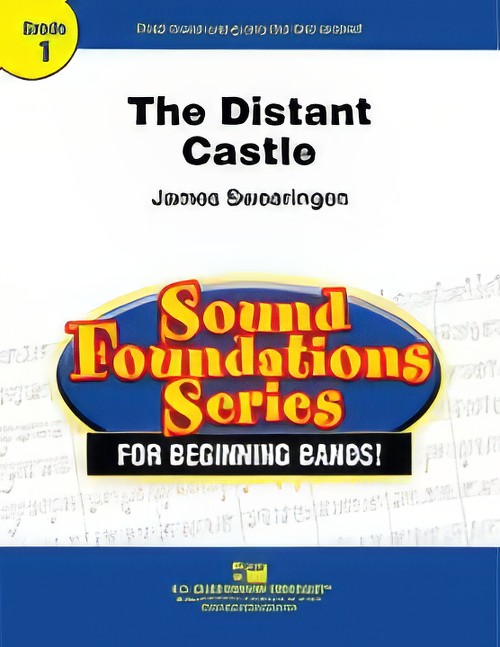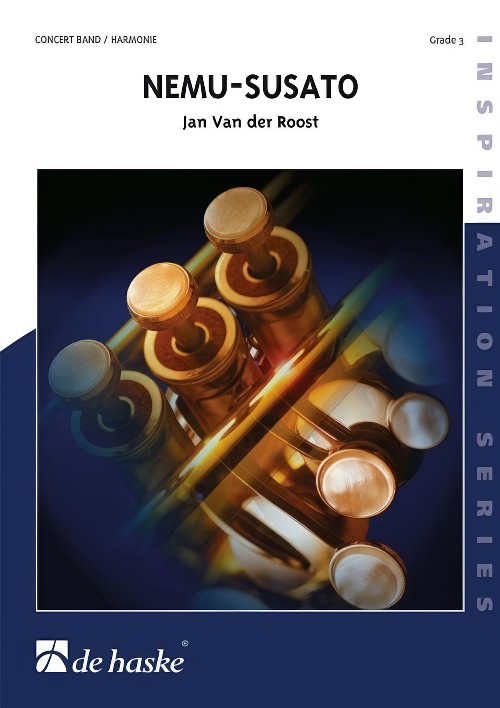Results
-
 £104.99
£104.99Song of Hope (Concert Band - Score and Parts) - Van der Roost, Jan
2011 was a disastrous year for Japan: on March 11 the northeast of the country suffered a violent earthquake, which triggered a huge tsunami and caused massive damage to people and the environment. The ensuing problems with the nuclear reactor at Fukushima only increased the misery: a black day in the country's history... One almost inevitable consequence of such dramatic circumstances is the particular damage suffered by the cultural arts. And so it was in Japan: various high school wind orchestras in the effected areas lost their practice rooms and/or instruments. It will take a long time before the damage suffered is repaired - and it will take great effort to overcome the psychological effects, too. Focusing on the latter, Yutada Nishida (director of The Bandwagon radio program) asked a few composers for a simple work that could be played by many orchestras. It just so happened that the Osakan Philharmonic Winds (with whom Jan Van der Roost had conducted a concert exclusively of his own works on September 25th) had had a similar idea. This concert saw the baptism of Song of Hope. This piece immediately struck a chord with musicians and audience alike: it begins bleakly in the low register and evolves to a more open, optimistic close. There really is hope for better times!Duration: 4:45
Estimated dispatch 7-14 working days
-
 £46.00
£46.00The Distant Castle (Concert Band - Score and Parts) - Swearingen, James
A musical portrait of the famous Black Castle, located in the city of Matsumoto, Japan, is vividly brought to life through themes that are both dramatic and bold. Featuring the percussion section throughout, The Distant Castle is educationally sound programming for any concert setting and your percussionists may enjoy the optional opportunity to perform on traditional Japanese Taiko drums. The culture, beauty and history of Japan come to life in this new work for the beginning band by James Swearingen. Very effective!Duration: 2.00
Estimated dispatch 7-14 working days
-
 £149.99
£149.99Nemu-Susato (Concert Band - Score and Parts) - Van der Roost, Jan
Commissioned by the Japan Band Clinic Committee of Yamaha for the Nemu Band Directors Clinic in Nemu no Sato, May 18-20, 1997. The surprising title of this work is an indication of its content. By combining the somewhat similar names 'Nemu no Sato' and 'Susato' into a new word, Jan Van der Roost has produced a significant and interesting subject. The Yamaha corporation has extensive facilities in Nemu no Sato, Japan, including a concert hall, recording studios, hotel and so on. Concerts, workshops, clinics and other events are held here, including the annual Nemu Band Directors Clinic, which consists of numerous musical events. Jan Van der Roost served as guest conductor and speaker in 1994. He was invited again for the 1997 clinic, this time with a composition assignment. The difficulty level of his piece was to be Grade 2 - 3 bands. With this in mind, Mr. Van der Roost strove to create a renaissance-like sound. Simultaneously he wished to create a tribute to Tielman Susato who, like Jan Van der Roost, lived and worked in Antwerp in the 16th century. The first performance of Nemu-Susato was conducted by the composer, performed by the Tokyo Metropolitan Police Band, and took place during the Nemu Band Directors Clinic on May 19, 1997.Duration: 6.00
Estimated dispatch 7-14 working days
-
 £158.40
£158.40Fourth Suite for Band
Subtitled "City of Music", this impressive 3 movement suite was commissioned by the City of Takasaki, Japan. The movements: Intrada, Aria, and March, all are written to challenge mature bands and this work displays why Alfred Reed's music is a favorite of upper level groups around the world. A major work by a major composer that has already been recorded and is available on a CD recording by the Kosei Wind Orchestra from Tokyo, Japan. World Class!
Estimated dispatch 7-14 working days
-
 £50.50
£50.50The Distant Castle - James Swearingen
A musical portrait of the famous Black Castle, located in the city of Matsumoto, Japan, is vividly brought to life through themes that are both dramatic and bold. Featuring the percussion section throughout, "The Distant Castle" is educationally sound programming for any concert setting and your percussionists may enjoy the optional opportunity to perform on traditional Japanese Taiko drums. The culture, beauty and history of Japan come to life in this work for the beginning band by James Swearingen. Very effective!
Estimated dispatch 7-14 working days
-
£68.99
Celtic Fantasy - Keiichi Kurokawa
"Celtic" is a widely used term. Its history and culture expands to modern day Spain, Portugal, and North America.However, in this piece, I have based my music on the typical "Celtic" areas of Ireland and Scotland.The Bagpipe drone at the beginning reappears several times.After the introduction, the music transitions to an Irish Reel, The Wind That Shakes The Barley. Reel is a fast tempo dance, often in 4/4 or 2/2 time.Next is the Scottish folksong Auld Lang Syne, known as "Hotaru no Hikari" in Japan.The third movement is called Scotland the Brave. It is often performed by military bagpipe ensembles. Once air is blown into the bag, there is a constant reservoir of sound for Great Highland Bagpipes.A Part (advanced) is a grade 2.5-3 in American grading system. B Part (beginner) is 1-1.5.B Part is accessible for elementary school and junior high school beginning band students in Japan. However, the drone-sounding sections require a certain technique to hold the sound steady.It is my sincere desire that beginning musicians understand the importance of fundamentals through performing good music.Keiichi Kurokawa
Estimated dispatch 7-14 working days
-
 £202.99
£202.99Gloriosa - Symphonic Poem for Band Movement 1 - Yasuhide Ito
A new acquisition by Bravo Music, this fresh printing of the 1990 masterwork by Yasuhide Ito features a newly engraved score, improved parts, good availability and value. This stirring and powerful homage to early Christianity in Japan profoundly and eloquently states the case of cross-cultural conflict and resolution.I. OratioThe Gregorian chant "Gloriosa" begins with the words, "O gloriosa Domina excelsa super sidera que te creavit provide lactasti sacro ubere." The first movement Oratio opens with bells sounding the hymn's initial phrases. The movement as a whole evokes the fervent prayers and suffering of the Crypto-Christians.II. CantusIII. Dies FestusCommissioned in 1989 and premiered in 1990 by the Sasebo Band of the Maritime Self-Defense Force of Kyushu, southern Japan.Gloriosa is inspired by the songs of the Kakure-Kirishitan (Crypto-Christians) of Kyushu who continued to practice their faith surreptitiously after the ban of Christianity, which had been introduced to that southern region in the mid-16th century by Roman Catholic missionary Francisco Xavier. The worship brought with it a variety of western music.Though Christianity was proscribed in 1612 by authority of the Tokugawa Shogunate in Edo (today Tokyo), Kakure-Kirishitan continued advocating sermons and disguised songs. Melodies and lyrics such as Gregorian chant were obliged to be "Japanized". For example, the Latin word "Gloriosa" was changed to "Gururiyoza." This adaptation of liturgy for survival inspired Ito to write this piece in order to reveal and solve this unique cultural mystery.The composer explains:"Nagasaki district in Kyushu region continued to accept foreign culture even during the seclusion period, as Japan's only window to the outer world. After the proscription of Christianity, the faith was preserved and handed down in secret in the Nagasaki and Shimabara areas of Kyushu region. My interest was piqued by the way in which the Latin words of Gregorian chants were gradually `Japanized' during the 200 years of hidden practice of the Christian faith. That music forms the basis of Gloriosa."Gloriosa, fusing Gregorian chant and Japanese folk music, displays the most sophisticated counterpoint yet found in any Japanese composition for wind orchestra.
Estimated dispatch 7-14 working days
-
£209.99
Gloriosa - Symphonic Poem for Band Mvt 2 & 3 - Yasuhide Ito
A new acquisition by Bravo Music, this fresh printing of the 1990 masterwork by Yasuhide Ito features a newly engraved score, improved parts, good availability and value. This stirring and powerful homage to early Christianity in Japan profoundly and eloquently states the case of cross-cultural conflict and resolution.I. OratioThe Gregorian chant "Gloriosa" begins with the words, "O gloriosa Domina excelsa super sidera que te creavit provide lactasti sacro ubere." The first movement Oratio opens with bells sounding the hymn's initial phrases. The movement as a whole evokes the fervent prayers and suffering of the Crypto-Christians.II. CantusIII. Dies FestusCommissioned in 1989 and premiered in 1990 by the Sasebo Band of the Maritime Self-Defense Force of Kyushu, southern Japan.Gloriosa is inspired by the songs of the Kakure-Kirishitan (Crypto-Christians) of Kyushu who continued to practice their faith surreptitiously after the ban of Christianity, which had been introduced to that southern region in the mid-16th century by Roman Catholic missionary Francisco Xavier. The worship brought with it a variety of western music.Though Christianity was proscribed in 1612 by authority of the Tokugawa Shogunate in Edo (today Tokyo), Kakure-Kirishitan continued advocating sermons and disguised songs. Melodies and lyrics such as Gregorian chant were obliged to be "Japanized". For example, the Latin word "Gloriosa" was changed to "Gururiyoza." This adaptation of liturgy for survival inspired Ito to write this piece in order to reveal and solve this unique cultural mystery.The composer explains:"Nagasaki district in Kyushu region continued to accept foreign culture even during the seclusion period, as Japan's only window to the outer world. After the proscription of Christianity, the faith was preserved and handed down in secret in the Nagasaki and Shimabara areas of Kyushu region. My interest was piqued by the way in which the Latin words of Gregorian chants were gradually `Japanized' during the 200 years of hidden practice of the Christian faith. That music forms the basis of Gloriosa."Gloriosa, fusing Gregorian chant and Japanese folk music, displays the most sophisticated counterpoint yet found in any Japanese composition for wind orchestra.
Estimated dispatch 7-14 working days
-
 £191.50
£191.50Fourth Suite for Band - Alfred Reed
Subtitled "City of Music", this impressive 3 movement suite was commissioned by the City of Takasaki, Japan. The movements: Intrada, Aria, and March, all are written to challenge mature bands and this work displays why Alfred Reed's music is a favorite of upper level groups around the world. A major work by a major composer that has already been recorded and is available on a CD recording by the Kosei Wind Orchestra from Tokyo, Japan. World Class!
Estimated dispatch 7-14 working days
-
 £104.99
£104.99Fanfare and Jubilation - Naoya Wada
Fanfare and Jubilation was commissioned by the Yahata Technical High School Band (Fukuoka, Japan) to celebrate the 40th edition of their annual concert, and is dedicated to its directors, Mr. Satoru Yoshihara and Ms. Akane Morimoto. The premiere took place on June 14, 2007 in Kitakyushu City, Fukuoka, Japan with Mr. Satoru Yoshihara conducting.The piece is comprised of two parts: a festive opening fanfare; and a scintillating melody that reflects the celebratory atmosphere. Its melodic character, uplifting mood and punchy wit make Fanfare and Jubilation equally suitable as an opening piece or a concert work.
Estimated dispatch 7-14 working days
